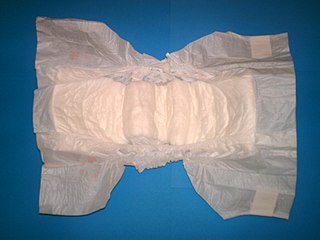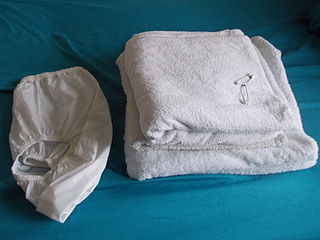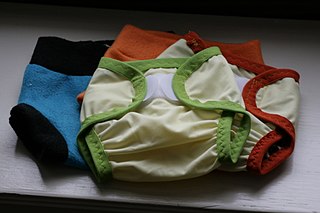
A diaper or a nappy is a type of underwear that allows the wearer to urinate or defecate without using a toilet, by absorbing or containing waste products to prevent soiling of outer clothing or the external environment. When diapers become wet or soiled, they require changing, generally by a second person such as a parent or caregiver. Failure to change a diaper on a sufficiently regular basis can result in skin problems around the area covered by the diaper.

Fetish fashion is any style or appearance in the form of a type of clothing or accessory, created to be extreme or provocative in a fetishistic manner. These styles are by definition not worn by the majority of people; if everyone wears an item, it cannot have fetishistic, special nature. They are usually made of materials such as leather, latex or synthetic rubber or plastic, nylon, PVC, spandex, fishnet, and stainless steel. Some fetish fashion items include: stiletto heel shoes and boots, hobble skirts, corsets, collars, full-body latex catsuits, stockings, miniskirt, crotchless underwear, jockstraps, diapers, garters, locks, rings, zippers, eyewear, handcuffs, and stylized costumes based on more traditional outfits, such as wedding dresses that are almost completely see-through lace, or lingerie for men.

Rubber fetishism, or latex fetishism, is the fetishistic attraction to people wearing latex clothing or, in certain cases, to the garments themselves. PVC fetishism is closely related to rubber fetishism, with the former referring to shiny clothes made of the synthetic plastic polyvinyl chloride (PVC) and the latter referring to clothes made of rubber, which is generally thicker, less shiny, and more matte than latex. PVC is sometimes confused with the similarly shiny patent leather, which is also a fetish material. Latex or rubber fetishists sometimes refer to themselves as "rubberists". Male rubberists tend to call themselves "rubbermen".

A dry suit or drysuit provides the wearer with environmental protection by way of thermal insulation and exclusion of water, and is worn by divers, boaters, water sports enthusiasts, and others who work or play in or near cold or contaminated water. A dry suit normally protects the whole body except the head, hands, and possibly the feet. In hazmat configurations, however, all of these are covered as well.

A raincoat is a waterproof or water-resistant garment worn on the upper body to shield the wearer from rain. The term rain jacket is sometimes used to refer to raincoats with long sleeves that are waist-length. A rain jacket may be combined with a pair of rain pants to make a rainsuit. Rain clothing may also be in one piece, like a boilersuit. Raincoats, like rain ponchos, offer the wearer hands-free protection from the rain and elements; unlike the umbrella.

A menstrual pad, or simply a pad, is an absorbent item worn by women in their underwear when menstruating, bleeding after giving birth, recovering from gynecologic surgery, experiencing a miscarriage or abortion, or in any other situation where it is necessary to absorb a flow of blood from the vagina. A menstrual pad is a type of menstrual hygiene product that is worn externally, unlike tampons and menstrual cups, which are worn inside the vagina. Pads are generally changed by being stripped off the pants and panties, taking out the old pad, sticking the new one on the inside of the panties and pulling them back on. Pads are recommended to be changed every 3–4 hours to avoid certain bacteria that can fester in blood; this time also may differ depending on the kind worn, flow, and the time it is worn.

Artificial leather, also called synthetic leather, is a material intended to substitute for leather in upholstery, clothing, footwear, and other uses where a leather-like finish is desired but the actual material is cost prohibitive or unsuitable, or for ethical concerns. Artificial leather is known under many names, including leatherette, imitation leather, faux leather, vegan leather, PU leather (polyurethane), and pleather.

A slip is a woman's undergarment worn beneath a dress or skirt. A full slip hangs from the shoulders, usually by means of narrow straps, and extends from the breast to the fashionable skirt length. A half slip hangs from the waist. The word petticoat may also be used for half slips.

Waterproofing is the process of making an object or structure waterproof or water-resistant so that it remains relatively unaffected by water or resisting the ingress of water under specified conditions. Such items may be used in wet environments or underwater to specified depths.

Latex rubber is used in the manufacture of many types of clothing. It has traditionally been used to make protective clothing, including gas masks and Wellington boots. Mackintoshes have traditionally been made from rubberized cloth. However, rubber has now generally been replaced in these applications by synthetic polymers.

A cloth diaper or a cloth nappy, also known as reusable diaper or reusable nappy, is a diaper made from textiles such as natural fibers, human-made materials, or a combination of both. Cloth diapers are in contrast to disposable diapers, made from synthetic fibers and plastics. They are often made from industrial cotton which may be bleached white or left the fiber’s natural color. Other natural fiber cloth materials include wool, bamboo, and unbleached hemp. Human-made materials such as an internal absorbent layer of microfiber toweling or an external waterproof layer of polyurethane laminate (PUL) may be used. Polyester fabrics microfleece or suedecloth are often used inside cloth diapers as a "stay-dry" wicking liner because of the non-absorbent properties of those synthetic fibers.

Polyurethane laminate is a compound fabric made by laminating a cloth fabric to one or both sides of a thin film of polyurethane. Polyurethane laminated fabrics have a wide range of applications in medical, automotive and garment uses.

See-through clothing is any garment of clothing made with lace, mesh or sheer fabric that allows the wearer's body or undergarments to be seen through its fabric. See-through fabrics were fashionable in Europe in the eighteenth century. There was a "sheer fashion trend" starting with designer clothing from 2008. See-through or sheer fabric, particularly in skintone colours, is sometimes called illusion, as in 'illusion bodice' due to giving the impression of exposed flesh, or a revealing ensemble.

Rubber pants or rubber panties were the predecessor to plastic pants and served the purpose of a diaper cover, replacing the woolen garment. However, "rubber pants" is still a generic term for any pull-on or snap-on incontinence protective garment.

Clothing fetishism or garment fetishism is a sexual fetish that revolves around a fixation upon a particular article or type of clothing, a particular fashion or uniform, or a person dressed in such a style.

Plastic clothing is clothing made from flexible sheets of plastics such as PVC, as distinct from clothing made from plastic-based synthetic fiber textiles such as polyester. Plastic clothing has existed almost since the creation of flexible plastic, particularly rain-protection garments made from waterproof fabrics.

Waxed cotton is cotton impregnated with a paraffin or natural beeswax based wax, woven into or applied to the cloth. Popular from the 1920s to the mid-1950s, the product, which developed from the sailing industry in England and Scotland, became commonly used for waterproofing. It has been replaced by more modern materials but is still used by the country sports community. The main drawbacks are two: waxed fabric is not very breathable and tends to be heavier and bulkier than modern synthetic waterproof materials.
Diaper fetishism, nappy fetishism, or diaperism is a type of garment fetish in which a person derives pleasure from wearing or using a diaper. Though separate and distinct, diaper fetishism can also be used as a component of various other kinks, such as ageplay or paraphilic infantilism, which together form a spectrum of practices colloquially referred to as "adult baby/diaper lover" or "AB/DL".

PVC clothing is shiny clothing made from the plastic polyvinyl chloride (PVC). PVC plastic is often called "vinyl" and this type of clothing is commonly known as "vinyl clothing". PVC is sometimes confused with the similarly shiny patent leather.
Valerie Hunter Gordon was the British inventor of PADDI, a sustainable nappy system considered to be the world's first disposable nappy, and Nikini, an early sanitary towel system.

















